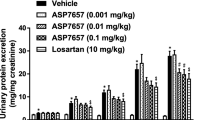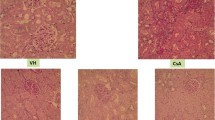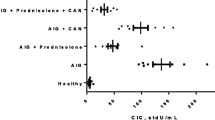Abstract
Background and methods
There is increasing evidence that a change in glomerular hemodynamics may promote the development of glomerulosclerosis. In this study, we focused on the pharmacological effects of 2 contrasting agents, etodolac, a preferential cyclooxygenase-2 inhibitor, and beraprost sodium (BPS), a prostaglandin I2 analog, delivered renally, on the disease course of progressive anti-Thy-1 (ATS) glomerulonephritis.
Results
Intravital microscopic analysis showed that the diameters of glomerular capillaries and glomerular blood flow in unilaterally nephrectomized (Nx) rats treated locally with BPS were significantly increased, as compared to those of Nx rats treated locally with normal saline (NS) or etodolac. We then examined the effects of BPS and etodolac on the course of progressive glomerulosclerosis. Mesangial cell proliferation, adhesion of glomerular capillary tufts and crescent formation in the BPS-treated group appeared to be more severe compared to the ATS + NS and the ATS + etodolac groups. Scoring of mesangial proliferation and glomerulosclerosis revealed that local BPS treatment significantly worsened glomerular pathology. At day 28, there were significant differences in blood flow between the ATS + etodolac group and both the ATS + NS and ATS + BPS groups, indicating that local treatment with etodolac enhanced the recovery of glomerular circulation.
Conclusion
This study provides hemodynamic-based evidence showing that disturbance of intraglomerular microcirculation is a critical marker for progressive glomerulonephritis.








Similar content being viewed by others
References
Hostetter TH, Olson JL, Rennke HG, Venkatachalam MA, Brenner BM. Hyperfiltration in remnant nephron: a potentially adverse response to renal ablation. Am J Physiol. 1981;241:F85–93.
Brenner BM. Remission of renal disease: recounting the challenge, acquiring the goal. J Clin Invest. 2002;110:1753–8.
Wada Y, Morioka T, Oyanagi-Tanaka Y, Yao J, Suzuki Y, Gejyo F, Aakawa M, et al. Impairment of vascular regeneration precedes progressive glomerulosclerosis in anti-Thy-1 glomerulonephritis. Kidney Int. 2002;61:432–43.
Oyanagi-Tanaka Y, Yao J, Wada Y, Morioka T, Suzuki Y, Gejyo F, et al. Real-time observation of hemodynamic changes in glomerular aneurysms induced by anti-Thy-1 antibody. Kidney Int. 2001;59:252–9.
Mahmood J, Khan F, Kumagai N, Morioka T, Oite T. Local delivery of angiotensin receptor blocker into the kidney ameliorates progression of experimental glomerulonephritis. Kidney Int. 2006;70:1591–8.
Harris RC, McKanna JA, Akai Y, Jacobson HR, Dubois RN, Breyer MD. Cyclooxygenase-2 is associated with the macula densa of rat kidney and increases with salt restriction. J Clin Invest. 1994;94:2504–10.
Jensen BL, Kurtz A. Differential regulation of renal cyclooxygenase mRNA by dietary salt intake. Kidney Int. 1997;52:1242–9.
Yang T, Singh I, Pham H, Sun D, Smart A, Schnermann JB, et al. Regulation of cyclooxygenase expression in the kidney by dietary salt intake. Am J Physiol. 1998;274:F481–9.
Wang JL, Cheng HF, Zhang MZ, McKanna JA, Harris RC. Selective increase of cyclooxygenase-2 expression in a model of renal ablation. Am J Physiol. 1998;275:F613–22.
Raij L, Azar S, Keane W. Mesangial immune injury, hypertension, and progressive glomerular damage in Dahl rats. Kidney Int. 1984;26:137–43.
Ikarashi K, Li B, Suwa M, Kawamura K, Morioka T, Yao J, et al. Bone marrow cells contribute to regeneration of damaged glomerular endothelial cells. Kidney Int. 2005;67:1925–33.
Kawamura K, Okada S, Li B, Suwa M, Yao J, Morioka T, et al. Turbulence of glomerular hemodynamics involved in progressive glomerulosclerosis. Kidney Int. 2006;69:1792–8.
Li B, Yao J, Kawamura K, Oyanagi-Tanaka Y, Hoshiyama M, Morioka T, et al. Real-time observation of glomerular hemodynamic changes in diabetic rats: effects of insulin and ARB. Kidney Int. 2004;66:1939–48.
Harris RC Jr. Cyclooxygenase-2 inhibition and renal physiology. Am J Cardiol. 2002;89(Suppl):10D–7D.
Cipollone F, Cicolini G, Bucci M. Cyclooxygenase and prostaglandin synthases in atherosclerosis: recent insights and future perspectives. Pharmacol Ther. 2008;118:161–80.
Wang JL, Cheng HF, Shappell S, Harris RC. A selective cyclooxygenase-2 inhibitor decreases proteinuria and retards progressive renal injury in rats. Kidney Int. 2000;57:2334–42.
Perazella MA, Eras J. Are selective COX-2 inhibitors nephrotoxic? Am J Kidney Dis. 2000;35:937–40.
Kitahara M, Eitner F, Ostendorf T, Kunter U, Janssen U, Westenfeld R, et al. Selective cyclooxygenase-2 inhibition impairs glomerular capillary healing in experimental glomerulonephritis. J Am Soc Nephrol. 2002;13:1261–70.
Poelstra K, Brouwer E, Baller JFW, Hardonk MJ, Bakker WW. Attenuation of anti-Thy1 glomerulonephritis in the rat by anti-inflammatory platelet-inhibiting agents. Am J Pathol. 1993;142:441–50.
Clark WF, Parbtani A, McDonald JW, Taylor N, Reid BD, Kreeft J. The effects of a thromboxane synthase inhibitor, a prostacyclin analog and PGE1 on the nephritis of the NZB/WF1 mouse. Clin Nephrol. 1987;28:288–94.
Yamashita T, Shikata K, Matsuda M, Okada S, Ogawa D, Sugimoto H, et al. Beraprost sodium, prostacyclin analogue, attenuates glomerular hyperfiltration and glomerular macrophage infiltration by modulating ecNOS expression in diabetic rats. Diabetes Res Clin Pract. 2002;57:149–61.
Yamada M, Sasaki R, Sato N, Suzuki M, Tamura M, Matsushita T, et al. Amelioration by beraprost sodium, a prostacyclin analogue, of established renal dysfunction in rat glomerulonephritis model. Eur J Pharmacol. 2002;449:167–76.
Acknowledgments
This study was supported by research grants from the Ministry of Education, Science, Sports and Culture, Japan (B: No. 15390266, C: No. 12671032, JSPS; 15/03138, to T.O. Grant-in-aid for young scientists B: No. 17790548 to J.M.), and grants from Novartis Pharmaceuticals and Nippon Shinyaku Co., Ltd.
Author information
Authors and Affiliations
Corresponding author
About this article
Cite this article
Nozawa, Y., Sato, A., Piao, H. et al. The effect of renal administration of a selective cyclooxygenase-2 inhibitor or stable prostaglandin I2 analog on the progression of sclerotic glomerulonephritis in rats. Clin Exp Nephrol 16, 221–230 (2012). https://doi.org/10.1007/s10157-011-0558-2
Received:
Accepted:
Published:
Issue Date:
DOI: https://doi.org/10.1007/s10157-011-0558-2




